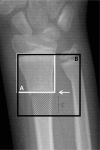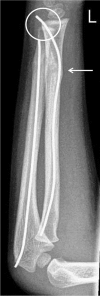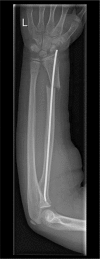Is there a standard treatment for displaced pediatric diametaphyseal forearm fractures?: A STROBE-compliant retrospective study
- PMID: 31305426
- PMCID: PMC6641800
- DOI: 10.1097/MD.0000000000016353
Is there a standard treatment for displaced pediatric diametaphyseal forearm fractures?: A STROBE-compliant retrospective study
Abstract
To review our institutional results and assess different surgical and non-surgical techniques for the treatment of displaced diametaphyseal forearm fractures in children and adolescents.Thirty-four children (25M, 9F) with a total of 36 diametaphyseal forearm fractures who underwent treatment under general anesthesia between July 2010 and February 2016 were recruited to this retrospective study. From October 2016 until March 2018 patients and/or parents were contacted by telephone and interviewed using a modified Pediatric Outcomes Data Collection Instrument (PODCI).Median age at the time of injury was 9.1 years (range, 1.9-14.6 years). Initial treatment included manipulation under anesthesia (MUA) and application of plaster of Paris (POP) (n = 9), elastic stable intramedullary nailing (ESIN) (n = 10), percutaneous insertion of at least one Kirschner wire (K-wire) (n = 16), and application of external fixation (n = 1). Eleven children (32%) experienced a total of 22 complications. Seven complications were considered as major, including delayed union (n = 1) and extensor pollicis longus (EPL) tendon injury (n = 1) following ESIN, as well as loss of reduction (n = 2) and refractures (n = 3) after MUA/POP. The median follow-up time was 28.8 months (range, 5.3-85.8 months). In 32 out of 34 cases (94%) patients and/or parents were contacted by telephone and a PODCI score was obtained. Patients who experienced complications in the course of treatment had a significantly lower score compared with those whose fracture healed without any sequelae (P = .001). There was a trend towards an unfavorable outcome following ESIN compared with K-wire fixation (P = .063), but not compared with POP (P = .553). No statistical significance was observed between children who were treated initially with a POP and those who had K-wire fixation (P = .216).There is no standard treatment for displaced pediatric diametaphyseal forearm fractures. Management with MUA/POP only is associated with an increased refracture rate. Based on our experience K-wire fixation including intramedullar positioning of at least one pin seems to be favorable compared with ESIN.
Conflict of interest statement
The authors have no conflicts of interest to disclose.
Figures





References
-
- Armstrong PF, Joughin VE, Clarke HM. Greene NE, Swiontkowski MF. Pediatric fractures of the forearm, wrist, and hand. Skeletal Trauma in Children. Philadelphia: Saunders; 1998. 161–257.
-
- Bae DS. Pediatric distal radius and forearm fractures. J Hand Surg Am 2008;33:1911–23. - PubMed
-
- Naranje SM, Erali RA, Warner WC, Jr, et al. Epidemiology of pediatric fractures presenting to Emergency Departments in the United States. J Pediatr Orthop 2016;36:e45–8. - PubMed
-
- Kosuge D, Barry M. Changing trends in the management of children's fractures. Bone Joint J 2015;97-B:442–8. - PubMed
-
- Schmittenbecher PP. State-of-the-art treatment of forearm shaft fractures. Injury 2005;36suppl:A25–34. - PubMed
MeSH terms
LinkOut - more resources
Full Text Sources
Medical

